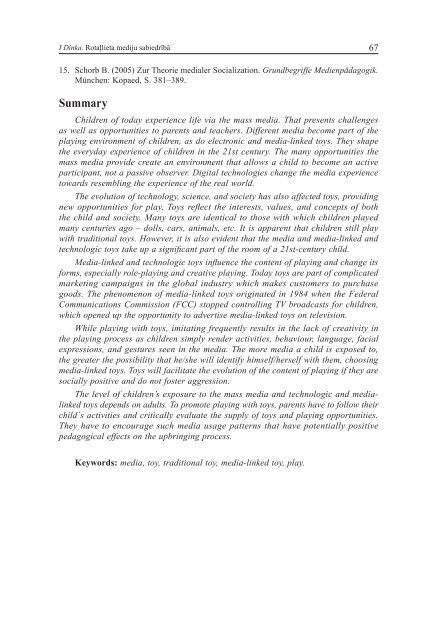You also want an ePaper? Increase the reach of your titles
YUMPU automatically turns print PDFs into web optimized ePapers that Google loves.
I Dinka. Rotaļlieta mediju sabiedrībā 67<br />
15. Schorb B. (2005) Zur Theorie medialer Socialization. Grundbegriffe Medienpädagogik.<br />
München: Kopaed, S. 381–389.<br />
Summary<br />
Children of today experience life via the mass media. That presents challenges<br />
as well as opportunities to parents and teachers. Different media become part of the<br />
playing environment of children, as do electronic and media-linked toys. They shape<br />
the everyday experience of children in the 21st century. The many opportunities the<br />
mass media provide create an environment that allows a child to become an active<br />
participant, not a passive observer. Digital technologies change the media experience<br />
towards resembling the experience of the real world.<br />
The evolution of technology, science, and society has also affected toys, providing<br />
new opportunities for play. Toys reflect the interests, values, and concepts of both<br />
the child and society. Many toys are identical to those with which children played<br />
many centuries ago – dolls, cars, animals, etc. It is apparent that children still play<br />
with traditional toys. However, it is also evident that the media and media-linked and<br />
technologic toys take up a significant part of the room of a 21st-century child.<br />
Media-linked and technologic toys influence the content of playing and change its<br />
forms, especially role-playing and creative playing. Today toys are part of complicated<br />
marketing campaigns in the global industry which makes customers to purchase<br />
goods. The phenomenon of media-linked toys originated in 1984 when the Federal<br />
Communications Commission (FCC) stopped controlling TV broadcasts for children,<br />
which opened up the opportunity to advertise media-linked toys on television.<br />
While playing with toys, imitating frequently results in the lack of creativity in<br />
the playing process as children simply render activities, behaviour, language, facial<br />
expressions, and gestures seen in the media. The more media a child is exposed to,<br />
the greater the possibility that he/she will identify himself/herself with them, choosing<br />
media-linked toys. Toys will facilitate the evolution of the content of playing if they are<br />
socially positive and do not foster aggression.<br />
The level of children’s exposure to the mass media and technologic and medialinked<br />
toys depends on adults. To promote playing with toys, parents have to follow their<br />
child`s activities and critically evaluate the supply of toys and playing opportunities.<br />
They have to encourage such media usage patterns that have potentially positive<br />
pedagogical effects on the upbringing process.<br />
Keywords: media, toy, traditional toy, media-linked toy, play.

















